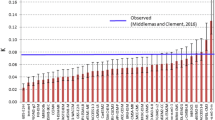Abstract
Air temperature feedback results from the thermal-radiative coupling between the atmosphere and the surface and plays an important role in surface energy balance. This paper reveals the contribution of air temperature feedback to the global warming from 1980 to 2000. The air temperature feedback kernel, evaluated using the ERA-Interim reanalysis data, is used to discuss the physical mechanism for air temperature feedback, the dependency of the strength of air temperature feedback on the climatological spatial distributions of air temperature, water vapor and cloud content, and the contributions of air temperature feedback to rapid global warming. The coupling between temperature feedback and each of the external forcings and individual feedback processes will amplify the anomaly of direct energy flux convergence at the surface induced by the external forcings and individual processes. The air temperature feedback amplifies the initial surface warming due to the increase in CO2 concentration, ice and snow melting, increase in water vapor, and change in ocean heat storage. It also amplifies the surface warming due to the longwave radiaitve forcing associated with the increase in cloud cover, which acts to suppress the cooling of the shortwave effect of cloud forcing. Overall, temperature feedback plays an important role in the global warming from 1980 to 2000, as the net positive contribution to the perturbation of global mean energy flux at the surface from the air temperature feedback is larger than the net negative contribution from external forcing and all non-temperature feedbacks.
Similar content being viewed by others
References
Adler R F, Huffman G J, Chang A, Ferraro R, Xie P P, Janowiak J, Rudolf B, Schneider U, Curtis S, Bolvin D, Gruber A, Susskind J, Arkin P, Nelkin E. 2003. The version-2 global precipitation climatology project (GPCP) monthly precipitation analysis (1979–present). J Hydrometeorol, 4: 1147–1167
Albrecht B A. 1989. Aerosols, cloud microphysics, and fractional cloudiness. Science, 245: 1227–1230
Auer I, Böhm R, Jurkovic A, Lipa W, Orlik A, Potzmann R, Schöner W, Ungersböck M, Matulla C, Briffa K, Jones P, Efthymiadis D, Brunetti M, Nanni T, Maugeri M, Mercalli L, Mestre O, Moisselin J M, Begert M, Müller-Westermeier G, Kveton V, Bochnicek O, Stastny P, Lapin M, Szalai S, Szentimrey T, Cegnar T, Dolinar M, Gajic-Capka M, Zaninovic K, Majstorovic Z, Nieplova E. 2007. HISTALP—Historical instrumental climatological surface time series of the greater alpine region. Int J Climatol, 27: 17–46
Brasseur G, Hitchman M H. 1988. Stratospheric response to trace gas perturbations: Changes in ozone and temperature distributions. Science, 240: 634–637
Cai M, Lu J H. 2009. A new framework for isolating individual feedback processes in coupled general circulation climate models. Part II: Method demonstrations and comparisons. Clim Dyn, 32: 887–900
Cai M, Tung K K. 2012. Robustness of dynamical feedbacks from radiative forcing: 2% solar versus 2×CO2 experiments in an idealized GCM. J Atmos Sci, 69: 2256–2271
Dai A, Karl T R, Sun B, Trenberth K E. 2006. Recent trends in cloudiness over the United States: A tale of monitoring inadequacies. Bull Amer Meteorol Soc, 87: 597–606
Dee D P, Uppala S M, Simmons A J, Berrisford P, Poli P, Kobayashi S, Andrae U, Balmaseda M A, Balsamo G, Bauer P, Bechtold P, Beljaars A C M, van de Berg L, Bidlot J, Bormann N, Delsol C, Dragani R, Fuentes M, Geer A J, Haimberger L, Healy S B, Hersbach H, Hólm E V, Isaksen L, Kållberg P, Köhler M, Matricardi M, McNally A P, Monge-Sanz B M, Morcrette J J, Park B K, Peubey C, de Rosnay P, Tavolato C, Thépaut J N, Vitart F. 2011. The ERA-Interim reanalysis: Configuration and performance of the data assimilation system. Q J R Meteorol Soc, 137: 553–597
Ding S, Zhao C, Shi G, Wu C. 2005. Analysis of global total cloud amount variation over the past 20 years (in Chinese). J Appl Meteorol, 16: 670–677
Eastman R, Warren S G. 2013. A 39-yr survey of cloud changes from land stations worldwide 1971–2009: Long-term trends, relation to aerosols, and expansion of the tropical belt. J Clim, 26: 1286–1303
Fu Q, Liou K N. 1993. Parameterization of the radiative properties of cirrus clouds. J Atmos Sci, 50: 2008–2025
Guan X, Huang J, Guo R, Lin P. 2015a. The role of dynamically induced variability in the recent warming trend slowdown over the Northern Hemisphere. Sci Rep, 5: 12669
Guan X, Huang J, Guo R, Yu H, Lin P, Zhang Y. 2015b. Role of radiatively forced temperature changes in enhanced semi-arid warming in the cold season over east Asia. Atmos Chem Phys, 15: 13777–13786
Hall A, Manabe S. 1999. The role of water vapor feedback in unperturbed climate variability and global warming. J Clim, 12: 2327–2346
Hansen J, Ruedy R, Sato M, Lo K. 2010. Global surface temperature change. Rev Geophys, 48: RG4004
Hansen J, Sato M, Ruedy R. 1997. Radiative forcing and climate response. J Geophys Res, 102: 6831–6864
Held I M, Soden B J. 2000. Water vapor feedback and global warming. Annu Rev Energy Environ, 25: 441–475
Held I M, Soden B J. 2006. Robust responses of the hydrological cycle to global warming. J Clim, 19: 5686–5699
Holland M M, Bitz C M. 2003. Polar amplification of climate change in coupled models. Clim Dyn, 21: 221–232
Hu X, Li Y, Yang S, Deng Y, Cai M. 2017. Process-based decomposition of the decadal climate difference between 2002–13 and 1984–95. J Clim, 30: 4373–4393
Huang J, Xie Y, Guan X, Li D, Ji F. 2017. The dynamics of the warming hiatus over the Northern Hemisphere. Clim Dyn, 48: 429–446
IPCC. 2013. Climate change 2013. In: Stocker T F, Qin D, Plattner G K, Tignor M, Allen S K, Boschung J, Nauels A, Xia Y, Bex V, Midgley P M, eds. The Physical Science Basis. Contribution of Working Group I to the Fifth Assessment Report of the Intergovernmental Panel on Climate Change. Cambridge: Cambridge University Press. 1535
IPCC. 2007: Climate change 2007. In: Solomon S, Qin D, Manning M. Chen Z, Marquis M, Averyt K B, Tignor M, Miller H L, eds. The Physical Science Basis, Contribution of Working Group I to the Fourth Assessment Report of the Intergovernmental Panel on Climate Change. Cambridge: Cambridge University Press
Jones P D, Moberg A. 2003. Hemispheric and large-scale surface air temperature variations: An extensive revision and an update to 2001. J Clim, 16: 206–223
Kaiser D P. 1998. Analysis of total cloud amount over China, 1951–1994. In: Proceedings of the Ninth Symposium on Global Change Studies. American Meteorological Society. Boston. 168–171
Li C, Weng H, Gao X, Zhong M. 2003. Initial investigation of another possible reason to cause global warming (in Chinese). Chin J Atmos Sci, 27: 789–797
Li J, Ren R, Qi Y, Wang F, Lu R, Zhang P, Jiang Z, Duan W, Yu F, Yang Y. 2013. Progress in air-land-sea interactions in Asia and their role in global and Asian climate change (in Chinese). Chin J Atmos Sci, 37: 518–538
Li L J, Wang B, Zhou T J. 2007. Impacts of external forcing on the 20th century global warming. Chin Sci Bull, 52: 3148–3154
Lu J H, Cai M. 2009. A new framework for isolating individual feedback processes in coupled general circulation climate models. Part I: Formulation. Clim Dyn, 32: 873–885
Maugeri M, Bagnati Z, Brunetti M, Nanni T. 2001. Trends in Italian total cloud amount, 1951–1996. Geophys Res Lett, 28: 4551–4554
Polyakov I V, Alekseev G V, Bekryaev R V, Bhatt U, Colony R L, Johnson M A, Karklin V P, Makshtas A P, Walsh D, Yulin A V. 2002. Observationally based assessment of polar amplification of global warming. Geophys Res Lett, 29: 25-1–25-4
Qian Y, Kaiser D P, Leung L R, Xu M. 2006. More frequent cloud-free sky and less surface solar radiation in China from 1955 to 2000. Geophys Res Lett, 33: L01812
Ramanathan V. 1977. Interactions between ice-albedo, lapse-rate and cloud-top feedbacks: An analysis of the nonlinear response of a GCM climate model. J Atmos Sci, 34: 1885–1897
Ramanathan V, Carmichael G. 2008. Global and regional climate changes due to black carbon. Nat Geosci, 1: 221–227
Rudolf B, Hauschild H, Rueth W, Schneider U. 1994. Terrestrial precipitation analysis: Operational method and required density of point measurements. In: Desbois M, Désalmand F, eds. Global Precipitations and Climate Change. NATO ASI Series (Series I: Global Environmental Change), vol 26. Berlin: Springer
Schneider E K, Kirtman B P, Lindzen R S. 1999. Tropospheric water vapor and climate sensitivity. J Atmos Sci, 56: 1649–1658
Sejas S A, Cai M. 2016. Isolating the temperature feedback loop and its effects on surface temperature. J Atmos Sci, 73: 3287–3303
Shell K M, Kiehl J T, Shields C A. 2008. Using the radiative kernel technique to calculate climate feedbacks in NCAR’s community atmospheric model. J Clim, 21: 2269–2282
Simmons A J, Jones P D, da Costa Bechtold V, Beljaars A C M, Kållberg P W, Saarinen S, Uppala S M, Viterbo P, Wedi N. 2004. Comparison of trends and low-frequency variability in CRU, ERA-40, and NCEP/NCAR analyses of surface air temperature. J Geophys Res, 109: D24115
Soden B J, Held I M, Colman R C, Shell K M, Kiehl J T, Shields C A. 2008. Quantifying climate feedbacks using radiative kernels. J Clim, 21: 3504–3520
Stephens G L, Li J, Wild M, Clayson C A, Loeb N, Kato S, L’Ecuyer T, Stackhouse P W, Lebsock M, Andrews T. 2012a. An update on Earth’s energy balance in light of the latest global observations. Nat Geosci, 5: 691–696
Stephens G L, Wild M, Stackhouse Jr P W, L’Ecuyer T, Kato S, Henderson D S. 2012b. The global character of the flux of downward longwave radiation. J Clim, 25: 2329–2340
Sun B, Groisman P Y. 2000. Cloudiness variations over the former Soviet Union. Int J Climatol, 20: 1097–1111
Taylor P C, Cai M, Hu A, Meehl J, Washington W, Zhang G J. 2013. A decomposition of feedback contributions to polar warming amplification. J Clim, 26: 7023–7043
Trenberth K E, Fasullo J, Smith L. 2005. Trends and variability in columnintegrated atmospheric water vapor. Clim Dyn, 24: 741–758
Tyndall J. 1861. On the absorption and radiation of heat by gases and vapours. Philos Mag, 22: 169–194, 273–285
Wang K C, Dickinson R E. 2013. Global atmospheric downward longwave radiation at the surface from ground-based observations, satellite retrievals, and reanalyses. Rev Geophys, 51: 150–185
Wetherald R T, Manabe S. 1988. Cloud feedback processes in a general circulation model. J Atmos Sci, 45: 1397–1416
Wu Z, Huang N E, Long S R, Peng C K. 2007. On the trend, detrending, and variability of nonlinear and nonstationary time series. Proc Natl Acad Sci USA, 104: 14889–14894
Zheng B, Shi C. 2006. Temperature cooling in lower stratosphere and its effects on zonal wind (in Chinese). Meteorol Sci Technol, 34: 538–541
Acknowledgements
This study was supported by the National Key Scientific Research Plan of China (Grant No. 2014CB953900), the Natural Science Foundation of Guangdong Province (Grant No. 2017A030310571), and the Fundamental Research Funds for the Central Universities (Grant No. 17LGPY21).
Author information
Authors and Affiliations
Corresponding author
Rights and permissions
About this article
Cite this article
Hu, X., Cai, M., Yang, S. et al. Air temperature feedback and its contribution to global warming. Sci. China Earth Sci. 61, 1491–1509 (2018). https://doi.org/10.1007/s11430-017-9226-6
Received:
Revised:
Accepted:
Published:
Issue Date:
DOI: https://doi.org/10.1007/s11430-017-9226-6




